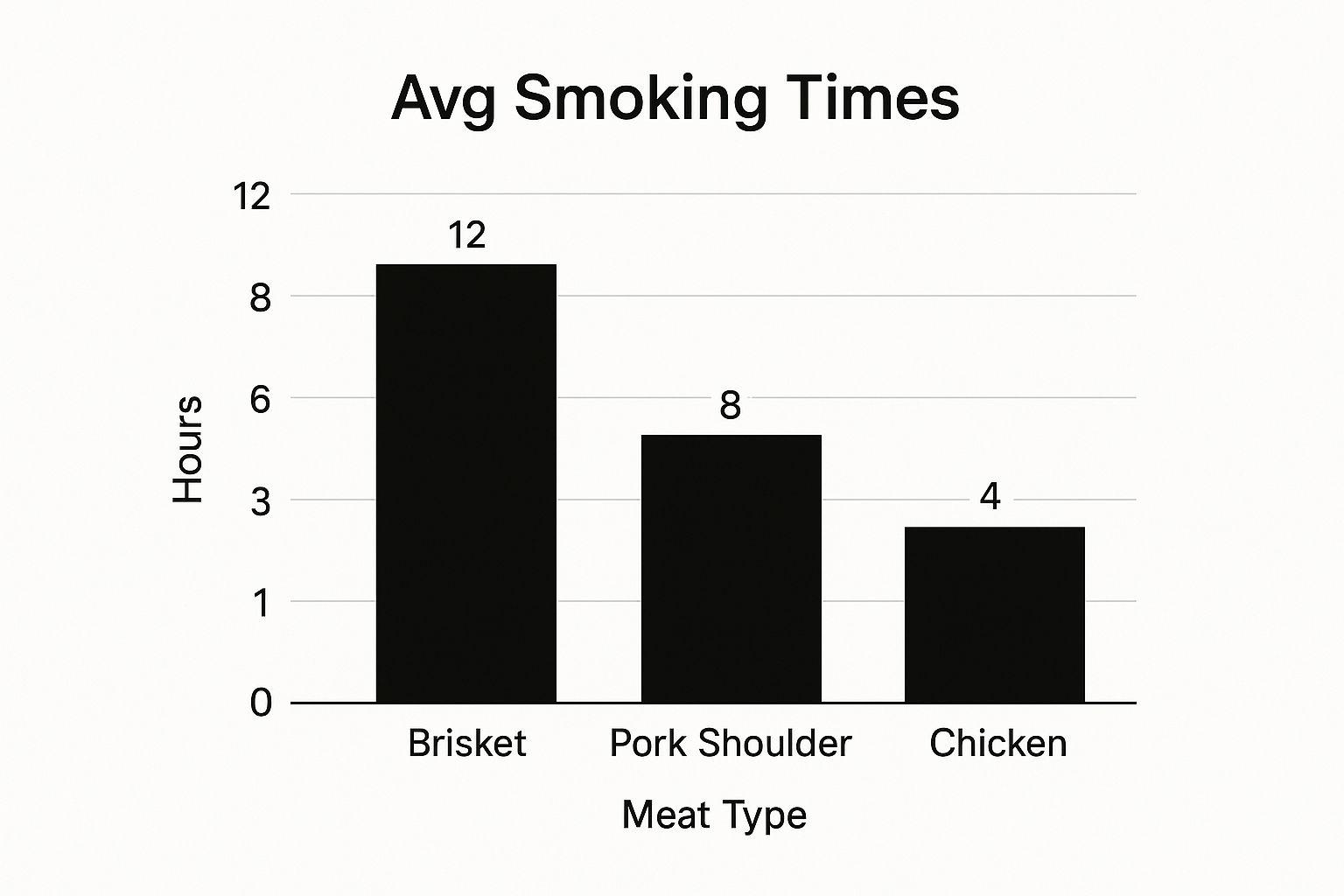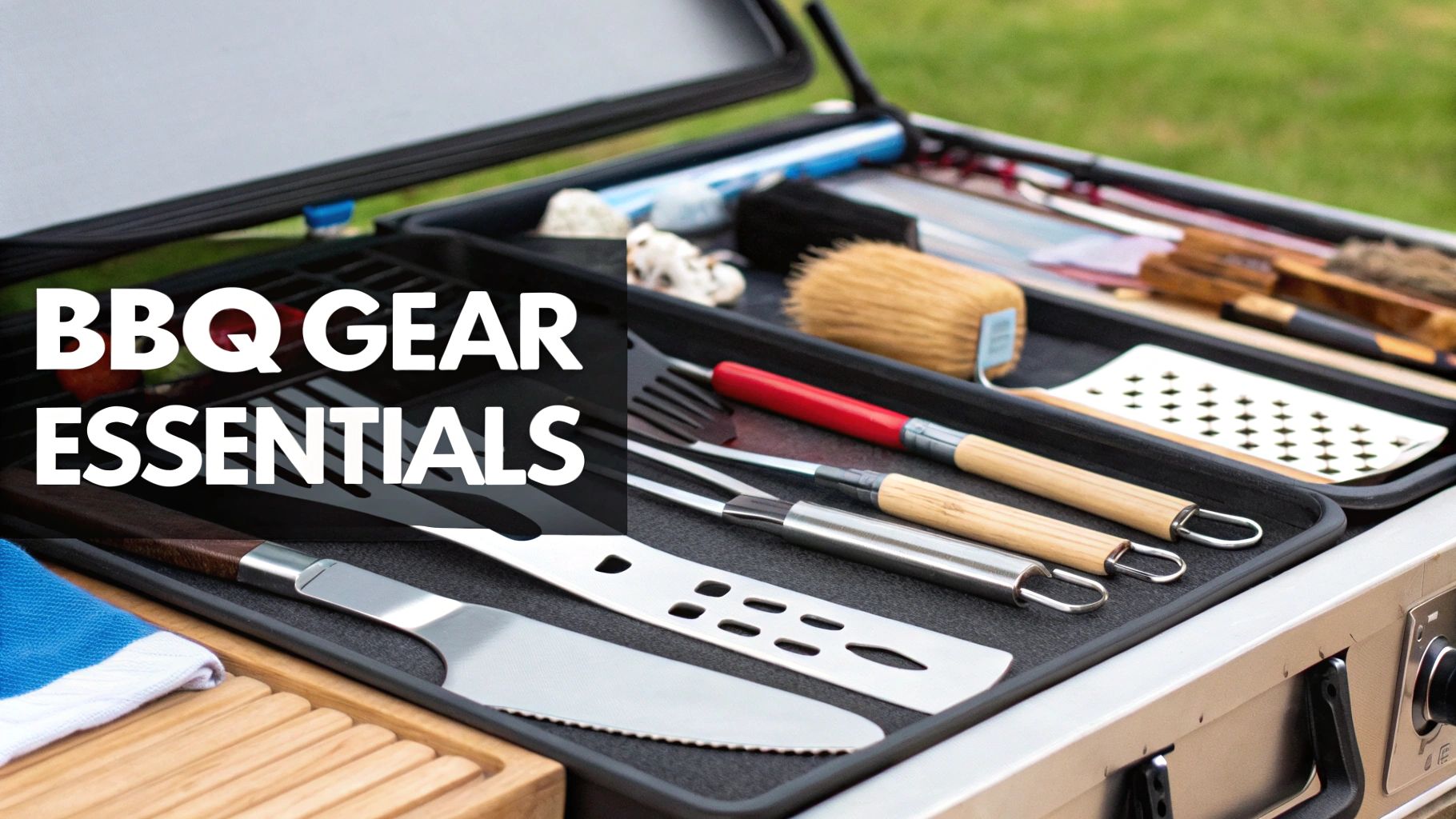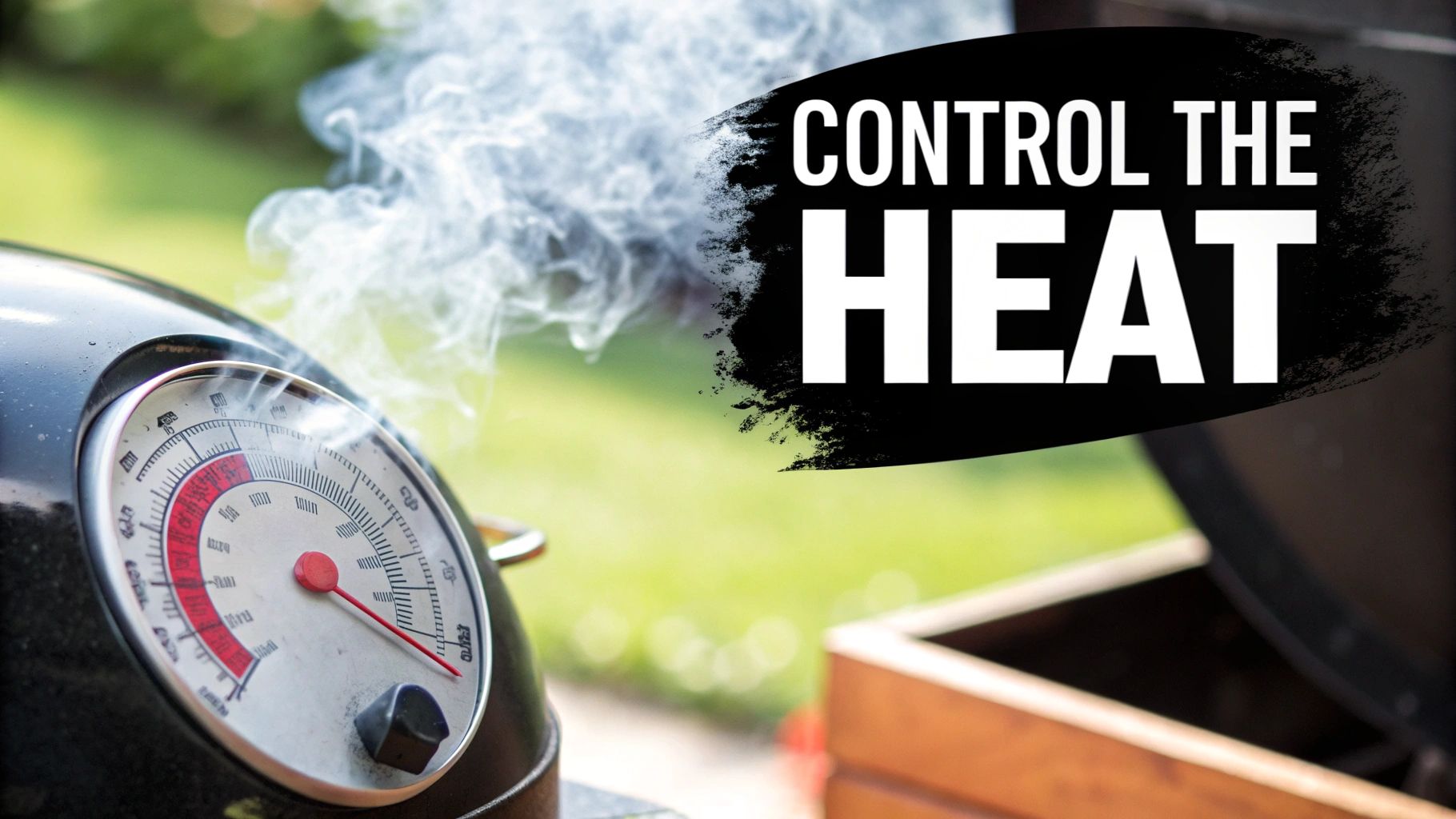Master Your BBQ With Smoker For Perfect Results
Diving into the world of low and slow BBQ is all about one thing: transforming a humble cut of meat into something truly special. It’s a craft, and the secret lies in two key ingredients: a steady, low temperature and clean, flavourful smoke.
This isn’t just for Texas-style brisket, either. Once you get the hang of it, you’ll unlock incredible flavour in everything from sticky pork ribs seasoned for BBQ perfection to a simple side of smoked vegetables.
Your Journey to Authentic Smoked BBQ Starts Here
Welcome. If you’re here, you’re ready to move beyond basic grilling and create some seriously good food. This guide gets straight to what matters most when you’re firing up a smoker: locking in that deep, smoky flavour that turns a simple meal into a proper event.
Forget the intimidating jargon. We’re focusing on the core principles that will give you the confidence to nail it from your very first cook, using authentic, cultural flavours with no added crap.
Using a smoker is a craft, and it’s one that’s getting seriously popular across the UK. It’s all part of a bigger shift towards creating amazing food experiences right in our own backyards. And it’s not just a passing trend—the numbers show a real investment in outdoor cooking, with the UK barbecue grill market set to hit approximately USD 348.7 million by 2025. It’s clear we all share a passion for making memorable food for our family and mates. Find out more about the UK BBQ market growth.
What This Guide Will Cover
Think of this as your practical companion for mastering the smoker. We’re here to help you:
- Get the Right Gear: We’ll cut through the noise and help you find the smoker and essential kit that actually suits your space and budget.
- Master Your Fire: Learn the fundamentals of temperature control and wood selection to get consistent, delicious results every single time.
- Level Up Your Food: Discover how to prep and season like a pro using real, no-crap seasonings designed to build that perfect, flavour-packed crust (or 'bark', as the pros call it).
Whether you’re firing up a smoker for the first time or you’re looking to perfect your technique, this is where your journey to incredible BBQ really begins.
Choosing the Right Smoker and Essential Gear
Before you can get that perfect smoky flavour, you need the right kit. Diving into the world of smokers can feel like a massive commitment, but trust me, it’s not about buying the biggest, shiniest machine on the market. It’s about matching the smoker to your cooking style and how much time you want to spend tending a fire.
The UK's love for proper BBQ has exploded. We’re a big part of Europe's $243.9 million BBQ industry, which just shows how many of us are serious about our outdoor cooking. The good news? That means there's a perfect smoker out there for every garden and every cook.
Finding Your Perfect Smoker
Let's cut through the noise and look at the main types you'll come across.
An offset smoker is the classic choice for BBQ purists. If you love the romance of managing a real wood fire and tweaking things as you go, this is your rig. On the other hand, a bullet smoker is a brilliant, space-saving option that's fantastic for beginners. You can get incredible results without having to babysit it constantly.
Then you have the tech-forward options. A pellet grill is the king of convenience, offering set-it-and-forget-it temperature control that’s a lifesaver for long, overnight cooks. And don't forget kamado-style ceramic grills. These are the versatile all-rounders of the BBQ world – incredibly fuel-efficient and just as good at smoking low-and-slow as they are at searing a steak at screaming-hot temperatures.
The best smoker for you is the one you'll actually use. Don't get caught up in features you don't need—focus on what fits your lifestyle, whether that’s convenience for busy weekends or total control for crafting the perfect brisket.

As you can see, the consistency of a pellet grill can be a real game-changer when you're facing a 12-hour brisket cook.
Before you buy, it’s worth weighing up the pros and cons of each type. This table should help you figure out which smoker is the best fit for your home setup.
Smoker Type Comparison For UK Home Cooks
| Smoker Type | Best For | Fuel Source | Ease of Use |
|---|---|---|---|
| Offset Smoker | Purists who love managing a real fire and cooking for a crowd. | Wood/Charcoal | High learning curve, needs constant attention. |
| Bullet Smoker | Beginners and those with limited space. Great for ribs and pork butt. | Charcoal | Fairly easy. Set it up and let it run for hours. |
| Pellet Grill | Convenience lovers who want consistent results with minimal effort. | Wood Pellets | Very easy. "Set it and forget it" temperature control. |
| Kamado Grill | Versatility. Perfect for smoking, searing, roasting, and even baking. | Charcoal | Moderate. Holds temperature brilliantly once you get the hang of it. |
Ultimately, the right choice comes down to how hands-on you want to be. There’s no wrong answer, only the one that gets you cooking more often.
The Non-Negotiable Accessories
Forget all the flashy gadgets you see online. Beyond the smoker itself, there are only a few key pieces of gear that will make your life easier and your food infinitely better. Start with the essentials that actually make a difference.
You absolutely need:
- A Reliable Digital Thermometer: This is, without a doubt, your most important tool. The secret to perfectly juicy meat is cooking to temperature, not time. An instant-read model is great, but a leave-in probe thermometer is even better for long cooks.
- Heat-Proof Gloves: You’ll be handling hot grates, charcoal chimneys, and massive cuts of meat. A decent pair of gloves isn’t just a nice-to-have, it’s a safety essential.
- A Charcoal Chimney Starter: If you’re using charcoal, a chimney is the cleanest and fastest way to get your coals lit. It saves you from using lighter fluid, which can leave a nasty chemical taste on your food.
Getting your setup right from the start makes all the difference. While we're talking about assembly, a clear and simple grill assembly guide can be a lifesaver for any new piece of outdoor cooking kit, ensuring it's built right and ready to go.
The Art of Smoke: Selecting Your Wood

Alright, your smoker is set up and raring to go. Now for the most important ingredient of all: the smoke itself. The wood you choose is what’ll turn a good bit of meat or veg into something genuinely special, adding layers of flavour that your kitchen oven can only dream of.
Forget what you’ve seen on TV. We’re not aiming for a huge, billowing white cloud. Great barbecue comes from a clean, consistent burn that produces a thin, almost invisible stream of smoke often called “blue smoke.” That’s where the magic is, infusing your food with incredible taste without any of that harsh, bitter soot.
Wood Formats: Chips, Chunks, or Pellets?
Before you even think about flavours, you need to pick the right format for your smoker and your cook. It makes a huge difference.
- Wood Chips: These are small, snappy pieces of wood that burn fast. They’re perfect for shorter cooks like fish or chicken, or for adding a quick burst of smokiness on a gas grill.
- Wood Chunks: Think fist-sized and dense. Chunks are the workhorse for low-and-slow sessions in charcoal smokers. They smoulder for hours, providing that steady, reliable smoke you need for brisket, pulled pork, and ribs.
- Wood Pellets: Made from compressed sawdust, these are the dedicated fuel for pellet grills. They give you amazing consistency and come in a massive range of flavours, making them incredibly easy to use.
The golden rule is to match the wood format to your smoker and your cooking time. Trying to fuel a 12-hour brisket cook with chips would be a nightmare of constant refuelling, while a massive chunk would completely overwhelm a delicate salmon fillet.
Building Your Flavour Library
The wall of wood bags at a BBQ shop can feel a bit much when you’re starting out. But honestly, you only need a few core types to get amazing results. Different woods bring different vibes, and learning how to pair them is what separates the novices from the pros.
If you're using a pellet grill, you'll find a massive range of options. For a deep dive into those, our guide to woodfire pellets has everything you need to know.
To get you started, here's a quick reference guide to help you choose with confidence.
Wood Flavour Profile Guide
This little table is your cheat sheet for matching wood to whatever you're cooking.
| Wood Type | Flavour Profile | Pairs Well With |
|---|---|---|
| Hickory | Strong, bacon-like, slightly sweet. A true BBQ classic. | Pork (especially ribs and pulled pork), beef, and chicken. |
| Oak | Medium, classic smoky flavour that isn't overpowering. | A fantastic all-rounder. Great for beef brisket, lamb, and sausages. |
| Apple | Mild, sweet, and subtly fruity. | Excellent for poultry, pork, and vegetables. A gentle smoke for delicate foods. |
| Cherry | Mild, fruity, and slightly sweet. Adds a beautiful dark colour. | Chicken, turkey, pork, and ham. Pairs well with other woods like hickory. |
| Pecan | A cousin to hickory but milder and nuttier. | A versatile choice for poultry, pork, and even baking on the smoker. |
The best way forward? Keep it simple. Pick one wood, maybe oak or apple, and really get to know it. Cook a few different things with it. Once you’re comfortable, you can start experimenting by mixing woods—a bit of hickory with some cherry, for instance—to create your own signature smoke profile. That’s how you find the flavour that makes your BBQ yours.
Prepping Your Meat: The Foundation of Flavour
Let’s be clear: exceptional flavour doesn’t start when the meat hits the smoker. It starts on the prep board. This is where you build the foundation for that incredible, crunchy, and deeply savoury crust—the bark—that every single one of us is chasing.
It's about more than just chucking some seasoning at a piece of meat. Getting the prep right is what guarantees an even cook and makes sure every bit of flavour soaks in.
Step 1: Trim for an Even Cook
Before you even think about reaching for a rub, you need to trim your meat properly. If you’re working with a big cut like a pork shoulder or a brisket, this means slicing off any hard, thick lumps of fat. They simply won't render down during a low-and-slow cook and you'll be left with a chewy mess.
At the same time, look for any thin, dangly bits of meat that are just going to catch and burn to a crisp. Your goal is to create a more uniform, almost aerodynamic shape. This little bit of effort helps the heat and smoke flow evenly around the whole cut, preventing some parts from drying out while others are still trying to catch up.
Step 2: Apply a Binder (Your Secret Weapon)
Ever wondered how pitmasters get that rub to stick perfectly and form a killer crust? The answer is a binder. A binder is just a thin layer you slick over the meat to give the seasoning something to grab onto. It doesn't need to be fancy – you're not trying to add a dominant flavour, just create a tacky surface for the rub to adhere to.
You've got a few solid options, and you probably have them in the kitchen already:
- Yellow Mustard: The absolute classic. It’s cheap, it works a treat, and that vinegary tang completely cooks off, leaving zero taste behind.
- Hot Sauce: A thin coat of your favourite hot sauce can add a subtle background warmth that complements the rub without stealing the show.
- Olive Oil: A simple, neutral choice that gets the job done perfectly well.
Whichever you choose, just apply a very thin, even layer across the entire surface. A little goes a long, long way.
Step 3: Seasoning for Maximum Flavour
Right, this is the main event – getting that seasoning on. Let’s walk through a practical example: how to season ribs for the smoker in 3 minutes. For this, we’ll use a shaker of our Smokey Rebel Sweet Surrender rub.
- Prep the Ribs: Pat a rack of St. Louis-style pork ribs completely dry. Flip them over and remove the tough membrane from the back using a paper towel for grip. This is non-negotiable for tender ribs.
- Apply the Binder: Slick on a very thin layer of yellow mustard. You just need enough to create a tacky surface.
- Season Generously: Grab your shaker of Sweet Surrender. Hold it about 12 inches above the ribs and let the rub fall evenly, like you're dusting a cake. This stops it from clumping. Get a generous coating on the top, bottom, and all the sides. You want to see the meat completely covered, but not caked in a thick, pasty layer.
- Let it Set: Let the seasoned ribs sit for about 15-20 minutes. You’ll see the rub start to look wet as it draws moisture from the meat. That's your cue. It’s ready for the smoker.
The real magic of a Smokey Rebel rub is its authentic flavour and clean ingredients. Our craft can packaging keeps the spices fresh, and we use 'no added crap', which means you taste the actual spices, not a load of fillers. This is what helps create a genuine, craft BBQ bark.
The timing of seasoning is a hot debate. Applying a rub the night before (dry brining) helps salt penetrate deeper, which is great for thick cuts like pork shoulder for pulled pork. But for ribs, seasoning just before they hit the smoke is perfect for building that distinct, flavour-packed crust. If you want to dive deeper, check out our guide on using dry rubs for meat.
Mastering Fire and Temperature Control

If smoke is the soul of BBQ, then getting your temperature right is its heartbeat. This is single-handedly the most important skill you can learn with a bbq with smoker. Nail this, and you turn what feels like guesswork into a repeatable craft.
You're not just cooking meat; you're creating the perfect, stable environment for fats and tough connective tissues to break down. That’s how you get that melt-in-your-mouth magic. For most low-and-slow cooks, this happens in a very specific sweet spot: somewhere between 110°C and 135°C (225°F to 275°F).
Holding your cooker steady in this zone for hours is what builds that legendary dark bark and infuses every last fibre with flavour.
Taming the Flames with Airflow
The vents on your smoker are your accelerator and brakes. It’s that simple. More air feeds the fire, making it hotter. Less air starves it, bringing the temperature down.
- Intake Vent (Bottom): This is your main control dial. It lets fresh oxygen in to feed your charcoal or wood. Even tiny adjustments here make a big difference over time.
- Exhaust Vent (Top/Chimney): This one pulls air through the smoker and lets the smoke out. A good rule of thumb is to always keep this at least partially open. If you don't, you’ll trap stale, sooty smoke, and your food will taste bitter.
Let’s imagine you've lit your charcoal and your smoker is flying past your target of 120°C. Your first move is to slightly close that bottom intake vent—maybe by a quarter inch. Now, wait. Give it at least 15 minutes to see how the temperature responds before you touch it again. Overcorrecting is a classic beginner's mistake. Patience is everything.
Handling Real-World Cooking Scenarios
Your smoker doesn't cook in a laboratory. The weather plays a massive role in managing your fire, and learning how to adapt is what separates the pros from the novices.
A windy day, for example, can act like a giant bellows, forcing air into your intake and sending your temperatures soaring. The fix? Position your smoker so the intake vent is sheltered from the wind. You’ll probably have to close it down more than you normally would to compensate.
On the flip side, cold and rainy days will literally suck the heat out of your smoker, making your fire work much harder. You might need to open the vents a bit more or even add a few extra briquettes to keep your target temperature locked in.
The real art of fire management isn't just setting a temperature; it's learning to anticipate and react. A quick glance at the weather forecast before you start can save you hours of frustration.
Then there's the dreaded "stall." This is when a big cut like a brisket or pork butt hits an internal temperature around 65-75°C and just… stops climbing. Sometimes for hours. Don’t panic! This is completely normal. It’s the meat sweating, and the evaporation is cooling the surface down.
You have two choices here: wrap the meat tightly in butcher's paper (the famous "Texas crutch") to power through it, or just ride it out. Both methods work, but wrapping will speed up your cook considerably.
Nailing the Finish: The Rest and Final Touches
Right, you’ve put in the hours, and now it’s time to land this thing. This is where all that patience pays off, and it’s the bit that separates a decent BBQ from a truly great one.
Let’s get one thing straight: cook to internal temperature, not to time. I can’t stress this enough. Every single cut of meat is different. The only way to know for sure that it’s done is with a reliable digital thermometer.
Forget the clock. Focus on the probe. That’s the secret to getting juicy, tender results every single time.
Key Temperature Milestones
Knowing your target temps is non-negotiable. These aren’t just random numbers; they’re the magic points where all that tough connective tissue and fat finally give up and render down into the melt-in-your-mouth goodness we’re all chasing.
Here are the critical targets for the low-and-slow classics:
- Pulled Pork: You’re aiming for an internal temperature around 96°C (205°F). The real test? The shoulder bone should slide out completely clean, with zero resistance.
- Brisket: The sweet spot is usually somewhere between 93°C and 96°C (200°F and 205°F). When you probe it, it should feel like pushing into a stick of soft butter. No drag, just pure tenderness.
- Pork Ribs: While a thermometer helps, ribs are more about feel. They’re ready when they’re pliable and have a good bend to them. You’ll also see the meat has pulled back from the ends of the bones.
The most overlooked step in barbecue is also the most critical: the rest. Pulling your meat off the smoker is only half the battle. Resting lets the muscle fibres relax and reabsorb all those incredible juices. Skip this, and you'll end up with a dry, tragic mess on your cutting board.
The Art of the Rest (It's Non-Negotiable)
Once your meat hits its target temperature, you must let it rest. And I’m not talking about a quick five-minute break on the side.
For big cuts like a pork butt or a whole brisket, wrap it tightly in butcher’s paper (or foil if you must), then pop it into a dry, insulated cooler. Let it sit for at least an hour. Honestly, two to three hours is even better. This small act of doing nothing makes all the difference.
Adding Those Final Layers of Flavour
The last 30 minutes or so of the cook is your window of opportunity to add a final, signature touch.
If you’re saucing ribs, now’s the time. A thin glaze of your favourite BBQ sauce will get nice and tacky without burning. Any earlier and all those sugars would just turn bitter and ruin the party.
For an extra pop of authentic flavour right before you serve, a finishing dust is a proper game-changer. A light sprinkle of your favourite rub just before serving adds a fresh hit of spice and complexity that wakes everything up. It’s that final touch that takes your BBQ from homemade to unforgettable.
FAQs for Your BBQ With Smoker
When you're just starting out with a bbq with smoker, a few questions are bound to pop up. Don't worry, we've all been there. Here are some straight-talking answers to the common snags new pitmasters run into.
What are the best BBQ seasonings for chicken?
For chicken, you want seasonings that complement its milder flavour without overpowering it. Sweet and savoury rubs with paprika, garlic powder, and a touch of brown sugar are fantastic. A rub with a bit of a kick, like one with cayenne or chipotle, also works wonders, especially for smoked wings. The key is to get a good, even coating for crispy, flavourful skin.
Should I season my meat the night before smoking?
This technique, called 'dry brining', is excellent for thick cuts of meat like a pork shoulder (for pulled pork) or a beef brisket. The salt in the rub has time to penetrate deep into the meat, helping it retain moisture during a long cook. For thinner cuts like ribs or chicken, seasoning 30-60 minutes before they go on the smoker is usually enough to build a fantastic crust.
Can I smoke vegetables in a BBQ with smoker?
Absolutely! A smoker is fantastic for vegetables. It adds a deep, smoky flavour you can't get anywhere else. Try smoking corn on the cob, bell peppers, onions, or even asparagus. A simple BBQ rub for vegetables can be just olive oil, salt, pepper, and a sprinkle of a good all-purpose BBQ seasoning. Smoke them until tender for an incredible side dish.
How Much Charcoal and Wood Do I Actually Need?
For a long, slow cook (think 8-12 hours for a pork butt or brisket), a good rule of thumb is to fill your charcoal basket about three-quarters of the way. Toss in 3-4 fist-sized chunks of your chosen wood right at the start. That’s it. You shouldn’t need any more wood later on. What you're aiming for is a steady stream of thin, almost invisible blue smoke.
Ready to build that perfect bark and get that authentic, smoky flavour? The secret is in the details—and the rub. Smokey Rebel makes small-batch, no-crap seasonings designed to make your BBQ unforgettable. Check out the full range at https://smokeyrebel.com.
Join our Mailing List
Sign up and get Smokey Rebel Recipes + weekly recipes straight to your inbox!
Recent articles
How to Smoke Brisket: A UK Guide to Perfect BBQ
Learn how smoke brisket with our complete UK guide. Get actionable tips on selection, smoking, and slicing for tender, juicy...
Read moreTop Tips for Perfect Spice Rubs for Meat
Master the art of spice rubs for meat! Discover tips to choose, apply, and enhance flavors for mouthwatering results every...
Read moreBest BBQ Seasoning Gift Sets for Every Grill Master
Discover the best BBQ seasoning gift sets for any occasion. Find curated flavour collections perfect for grill lovers and adventurous...
Read more


